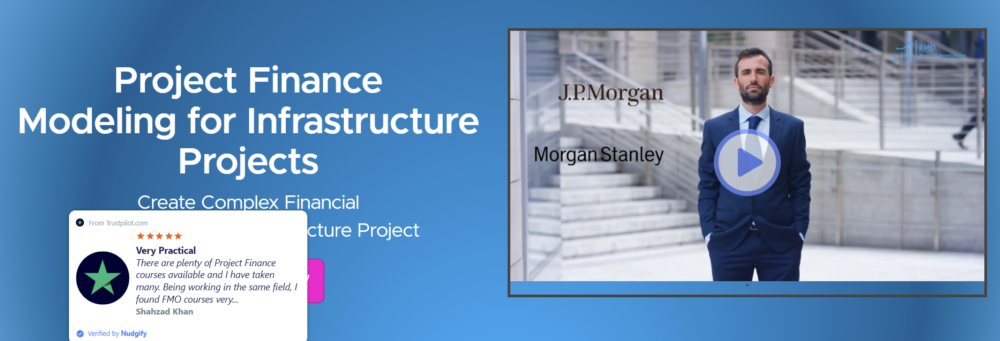Gregory Ahuy & Bekzod Kasimov – Project Finance Modeling for Infrastructure Projects

Project Finance Modeling Course Objectives
Project Finance Modeling course will give you the skills to develop and analyze project finance models for infrastructure projects. The course covers essential topics in project finance modeling including debt sizing and funding, project operations, and investment returns, and will provide you with a robust financial modeling skillset for analysis of infrastructure projects.
In an online environment you will go from a blank Excel workbook to a financial model suitable for investment analysis, debt structuring and operational scenario evaluation.
This course will provide step-by-step instructions on how to build financial model suitable for analyzing project finance transactions.
By this end of this course, you will be able to build complex, real-life project finance models.
What This Course is About?
Project finance models are used to assess the risk-reward of lending to and investing in an infrastructure project. The project’s debt capacity, valuation and financial feasibility depend on expected future cash flows generated by the project itself and a financial model is built to analyze this.
In The Project Finance Modeling course we will model complex greenfield toll road project finance transactions from scratch in excel.
You will learn about:
- what is project finance
- financial modeling of complex, real-life project finance transactions
- how to sculpt debt to a target DSCR
- how to create best practice macro’s and VBA codes to break circularities
- how to model Debt Service Reserve Account and Maintenance Reserve Account;
- how to model Shareholder Loan, Revolver and Blended Equity IRR
- building project finance models in excel that cover the entire life of the project
- carry out valuation analysis based on the discounted cash flow (DCF) and internal rate of return (IRR) methods
- preparing trusted project finance models tailored to investors and financiers, with a focus on valuation and risk
- financial models that are designed according to the F.A.S.T standards
This is the same comprehensive financial training used to prepare analysts and managers at top financial institutions and infrastructure funds.
How Does It Work?
The course length is over 9 hours.
First, we will review basic project finance theory, so you understand all essential components of project finance transaction.
Then, in the second part, we will go over the toll road project case study and review modeling methods to improve our productivity in excel. We will then dive into building our project finance model. We will work on the construction costs, funding and financing fees.
In the third part, we will build fully integrated, 3 statements financial model which will include income statement, balance sheet and cash flow statement.
In the forth part, we will model such items as coverage ratios, debt sculpting, debt service reserve account and maintenance reserve account, revolver, shareholder loan. We will also carry out valuation of the project using discounted cash flow ( DCF ) and internal rate of return ( IRR ) methods. This is a core part of any project finance model.
Finally, in the fifth part, we will introduce advanced financial modeling topics such as equity first funding method, debt sizing automation, debt service reserve account automation and scenario analysis.
Is This Course For You?
Yes, if you need to build, review or analyse project finance models within the infrastructure, oil & gas or mining sectors.
Typical students include analysts, managers, senior managers, associate directors, financial advisors, financiers and CFOs from project companies, investment banks, private equity and infrastructure funds.
Course Prerequisites
You will need previous exposure to Excel in a financial modelling context and basic knowledge of investment concepts such as NPV and cash flows.
Check Out Detailed Course Curriculum
Course Introduction
- Introduction to Project Finance Modeling Course(3:01)Preview
Part 1 – Project Finance Primer
- What Is Project Finance?(5:38)Preview
- Project Finance in Numbers(2:29)
- Financial Players in Project Finance(5:32)
- Industrial Players in Project Finance(3:04)
- Role of the Government in Project Finance(3:44)
- Risk Analysis in Project Finance(9:53)
- Capital & Operating Cash Flows(4:02)
- Control Accounts & Cash Flow Waterfall(5:32)
- Covenants in Project Finance(4:16)
- Quezon Power Plant Project Case Study – 1(9:49)Preview
- Quezon Power Plant Project Case Study – 2(4:59)
Part 2 – Case Review, Timeline, Construction Cost & Construction Funding Modeling
- Welcome to Part 2 !!!(0:37)Preview
Introduction to Modeling
- Introduction to the Case Study(8:38)Preview
- Calculations in Blocks(10:23)
- Paste Forward Link(4:30)
- Daisy Chains and Link Formatting(3:55)
- Most Used Excel Shortcut Keys(7:52)
- Using Placeholders(2:13)
- Excel Refresher – Understanding Anchoring(3:52)Preview
- Excel Refresher – Understanding Dates(5:25)
- Excel Refresher – Understanding IF Statements(4:52)
- Excel Refresher – Understanding SUMIF Function(6:04)
- Excel Refresher – Understanding LOOKUP Functions(5:37)
- Excel Refresher – Understanding MIN MAX Functions(2:38)
Timeline Development
- Understanding Timing(2:02)
- Modeling Timing – 1(5:46)
- Modeling Timing – 2(6:30)
- Modeling Timing – 3(5:48)
- Modeling Timing – 4(6:34)
Escalation
- Understanding Escalation(2:43)
- Modeling Escalation(6:43)
Construction Costs
- Understanding Construction Costs(2:12)
- Modeling Construction Costs(6:43)Preview
Construction Funding
- Understanding Construction Funding(1:40)Preview
- Modeling Construction Funding(7:04)
Financing Costs
- Understanding Financing Costs(3:39)
- Modeling Financing Costs – 1(6:57)
- Modeling Financing Costs – 2(5:36)
Part 3 – Modeling Financial Statements
- Welcome to Part 3 !!!(0:22)
Revenue
- Understanding Revenue(1:43)
- Modeling Revenue(6:44)
Operating Cost
- Understanding Operating Cost(1:46)
- Modeling Operating Cost(6:29)
Non – Current Assets
- Understanding Non – Current Assets(1:44)
- Modeling Non – Current Assets 1(5:53)
- Modeling Non – Current Assets 2(7:33)
Working Capital
- Understanding Working Capital(2:38)
- Modeling Working Capital(10:01)
Term Loan
- Understanding Term Loan(1:39)
- Modeling Term Loan(8:19)
Tax
- Understanding Taxes(2:25)
- Modeling Taxes – 1(5:17)
- Modeling Taxes – 2(7:51)
Equity, Cash and Dividends
- Understanding Equity and Dividends(3:14)
- Modeling Equity, Cash and Dividends – 1(5:46)
- Modeling Equity, Cash and Dividends – 2(7:42)
Part 4 – Modeling Project Finance
- Welcome to Part 4 !!!(0:32)Preview
Debt Service Coverage Ratio (“DSCR”)
- Understanding DSCR(6:23)
- Modeling DSCR – 1(8:41)
- Modeling DSCR – 2(8:05)
Loan Life & Project Life Cover Ratios (“LLCR” & “PLCR”)
- Understanding LLCR & PLCR(5:30)Preview
- Modeling LLCR(8:24)
- Modeling PLCR(10:47)
Debt Sculpting
- Understanding Debt Sculpting(4:46)
- Sculpted debt modeling(8:32)
Debt Service Reserve Account (“DSRA”)
- Understanding DSRA – 1(2:24)
- Understanding DSRA – 2(5:24)
- Modeling DSRA – 1(8:42)
- Modeling DSRA – 2(9:55)
Maintenance Reserve Account (“MRA”)
- Understanding MRA – 1(2:25)
- Understanding MRA – 2(4:23)
- Modeling MRA – 1(9:19)
- Modeling MRA – 2(10:18)
Revolving Credit Facility
- Understanding Revolving Credit Facility – 1(2:14)
- Understanding Revolving Credit Facility – 2(4:46)
- Modeling Revolving Credit Facility -1(10:05)
- Modeling Revolving Credit Facility – 2(10:25)
Shareholder Loan
- Understanding Shareholder Loan – 1(3:06)
- Understanding Shareholder Loan – 2(4:23)
- Modeling Shareholder Loan – 1(7:43)
- Modeling Shareholder Loan – 2(6:53)
- Course Review
Automation and Breaking Circularity With Excel VBA
- Understanding Circular References in Project Finance Models(2:35)
- Goal Seek Automation Macro(10:06)
- Breaking Circularity in Project Finance Models(12:58)
Valuation Analysis
- Understanding Valuation(6:06)
- Valuation(14:05)
Optimization
- Implementing Model Optimization(5:56)
Modeling Track Sheet and Checks
- Implementing Track Sheet(10:02)
- Modeling Checks(7:31)
Sensitivity and Scenario Analysis
- Sensitivity Analysis(4:39)
- Scenario Manager(6:22)
Part 5 – Advanced Project Finance Modeling Techniques
- Welcome to Part 5 !!!(0:47)
Equity First – Debt Drawdown Method
- Understanding Equity First Debt Drawdown Method(1:20)
- Equity First Funding – 1(9:57)
- Equity First Funding – 2(6:17)
- Equity First Funding – 3(6:42)
Debt Sizing Automation
- Understanding Debt Sizing(2:41)
- Debt Sizing – 1(14:20)
- Debt Sizing – 2(7:20)
Revisiting Debt Service Reserve Account
Revisiting Scenario Analysis
- Automating Scenario Analysis – 1(8:02)
- Automating Scenario Analysis – 2(13:31)
Course Review




You must be <a href="https://wislibrary.net/my-account/">logged in</a> to post a review.